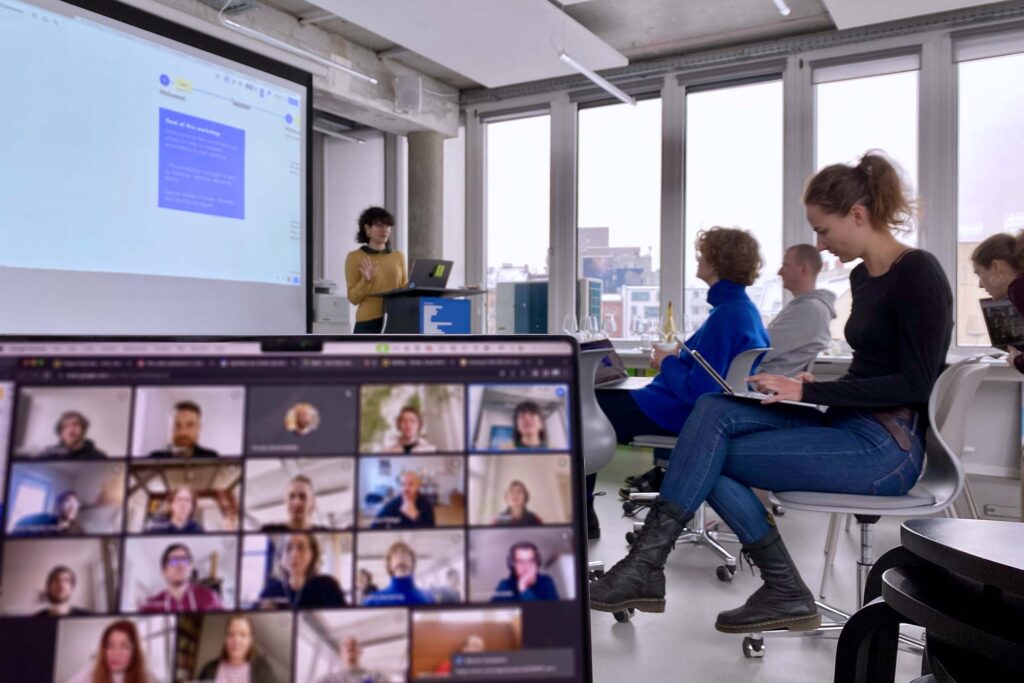This week felt productive. But it isn’t easy to evidence that feeling.
I had encouraging conversations with several people inside and outside of Digital Service.
Finishing the week, we hosted a day-long workshop on design system collaboration with various German public sector organisations. It included colleagues from municipality-level IT provider AKDB, state-level IT provider Dataport, the Federal Information Technology Centre (ITZBund), and the state of Schleswig-Holstein. The AKDB colleagues coordinated and facilitated the day. We served croissants and provided sticky notes and the space.
Following up on a design system-related community exchange in late September, we shared the work we do independently on component libraries in our organisations. We expressed our hopes to de-duplicate efforts, formulated visions of what a changed world of 2029 could look like, and pondered how we could practically work together.
All 4 design systems we looked at – the Kern Design System, ITZBund’s design system for accessibility, AKDB’s design system, and Digital Service’s Angie design system have plenty in common and overlap massively. From a tax payers’ perspective, it’s difficult to justify these and many more development efforts. Surely, they all serve different parts of government and the public sector in different parts of the country to deliver different services – some public servant-facing systems, others citizen-facing. Still, they have too much in common. How many different button radiuses do public sector organisations need? How many tertiary link styles? And how many check box appearances?
We closed our 7-hour exchange in gratitude, with optimism and a clear commitment to reconvene in a few weeks to compare what we have created in more detail. We recognise that current structures don’t incentivise us to work together, actively collaborate on products and services and co-create offerings. It’s the obvious and right thing to do, though, because there are much more urgent and much harder design problems to solve than button styles, page layouts and pattern definitions.
Talking about all the important things, again, as always
The other days of the week weren’t less exchange-heavy.
On Wednesday, I went to talk about the Service Standard with the Federal Ministry of Interior’s unit that practically owns it and the National Regulatory Control Council that initially proposed a German Service Standard back in 2016. We updated each other on the work we do, compared efforts and discussed how we can productively join up. I shared the structures we have created around peer reviews against the Service Standard and invited colleagues to join the upcoming one we run for a case-working system for federal courts in a couple of weeks. I also brought the theory of change for getting Service Standard adoption in Germany, which Caro and I developed in the past few months. After experimenting with the different frameworks, we followed the structure and style of a model developed by the non-profit Because. I shared physical copies with some people. I want to refine it further and publish it on Github soon.

On Thursday, we had a broader exchange at the snowy Federal Chancellery about challenges and opportunities in digital transformation. At the risk of sounding like a broken record, I talked about GDS’s origins, its offerings, and the essential building blocks for initiating fundamental change. I highlighted the importance of mandatory shared quality standards for services and in-house capability.
For 3 days in a row, I handed out the recently printed Service Standard posters. And I will continue to do so until it’s widely known and adopted. For the moment, I have about 230 posters left.
In our weekly all-hands, Marion and I reserved some minutes to give an update on accessibility efforts at Digital Service. We had never talked about accessibility in that format before, so it was about time. We offered a recap of the past 1.5 years, mentioning the ‘introduction to accessibility’ training for new starters, the 4 pizza-powered accessibility checks we have run so far, and the revived activities of our accessibility ambassador group. Giving an outlook on what we plan next, we talked about further capability building, training and events. In early February, Marion will talk about our accessibility work at the Service Design Drinks Berlin. In mid-May, we plan to participate in Global Accessibility Awareness Day.
Just an hour after our update, I supported Marion in our first cross-discipline accessibility workshop. Kicking a new awareness and capability-building format off, we took over and merged the engineers’ and the user-centred designers’ weekly discipline exchanges.
We spent an hour exploring – in the existing product and service teams – how developers, designers and user researchers are ensuring WCAG guidelines for 10 selected areas. The results were small cross-discipline process diagrams and plenty of questions. It feels like we are still at the beginning of our accessibility journey. The encouraging part, though: Many people are highly motivated to engage in the efforts.

With some delay, Kara, Viktoria and I got our blog post on ‘Co-creating the most complete overview of international design in government work’ published on the ‘Design in government’ blog. That means I have consistently blogged there for 6 years and without a break. I’m glad about us continuing this essential international exchange work.
What’s next
Next week, on Friday, Kara, Viktoria, and I will meet in person in London to discuss community efforts and activities for 2024. We will need to sketch how we can support a community day or pre-conference day in Helsinki in early October.
On Tuesday, Caro and I will separately meet with the service team and the peer reviewers for our upcoming Service Standard peer review in early February. We are getting more routined at briefing both groups and should soon be able to share our material more widely and openly.

